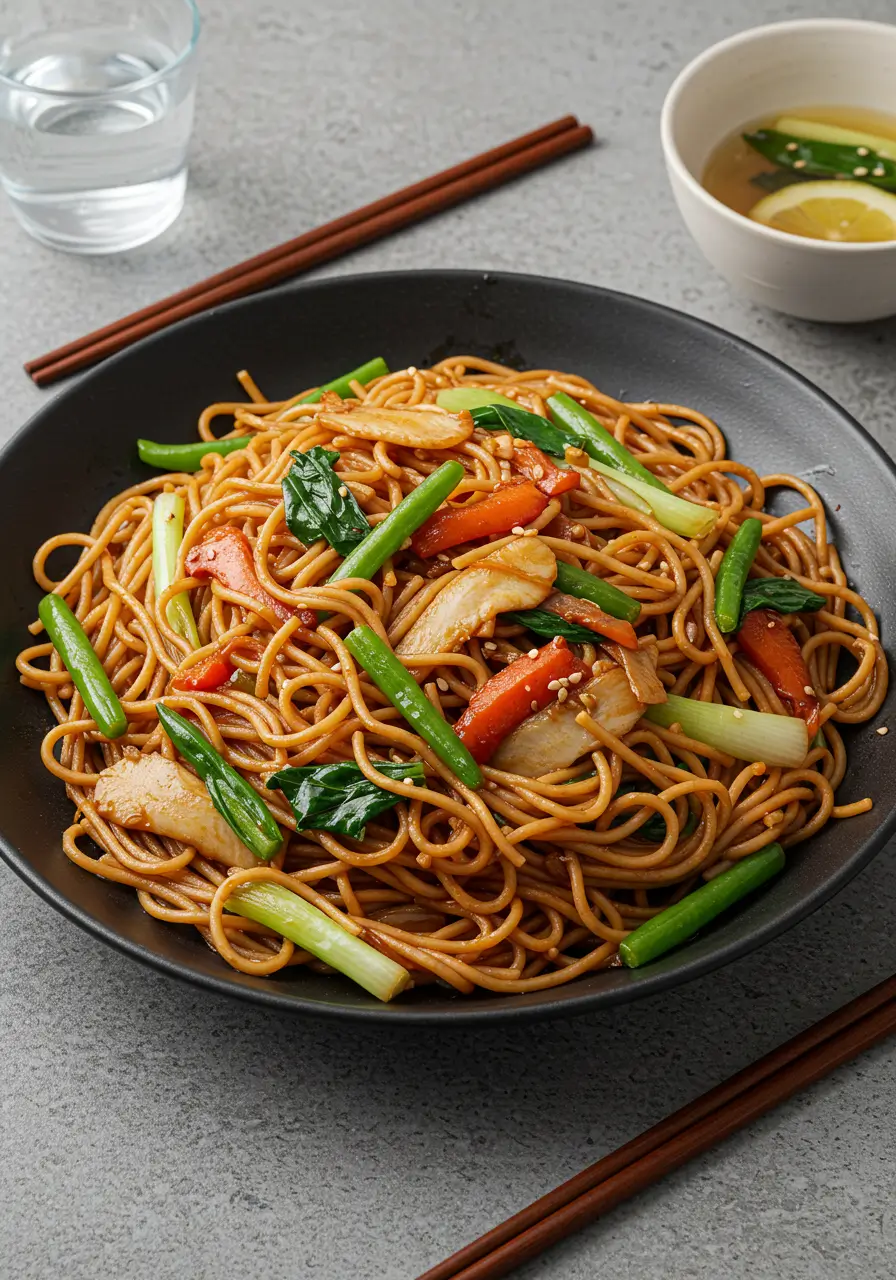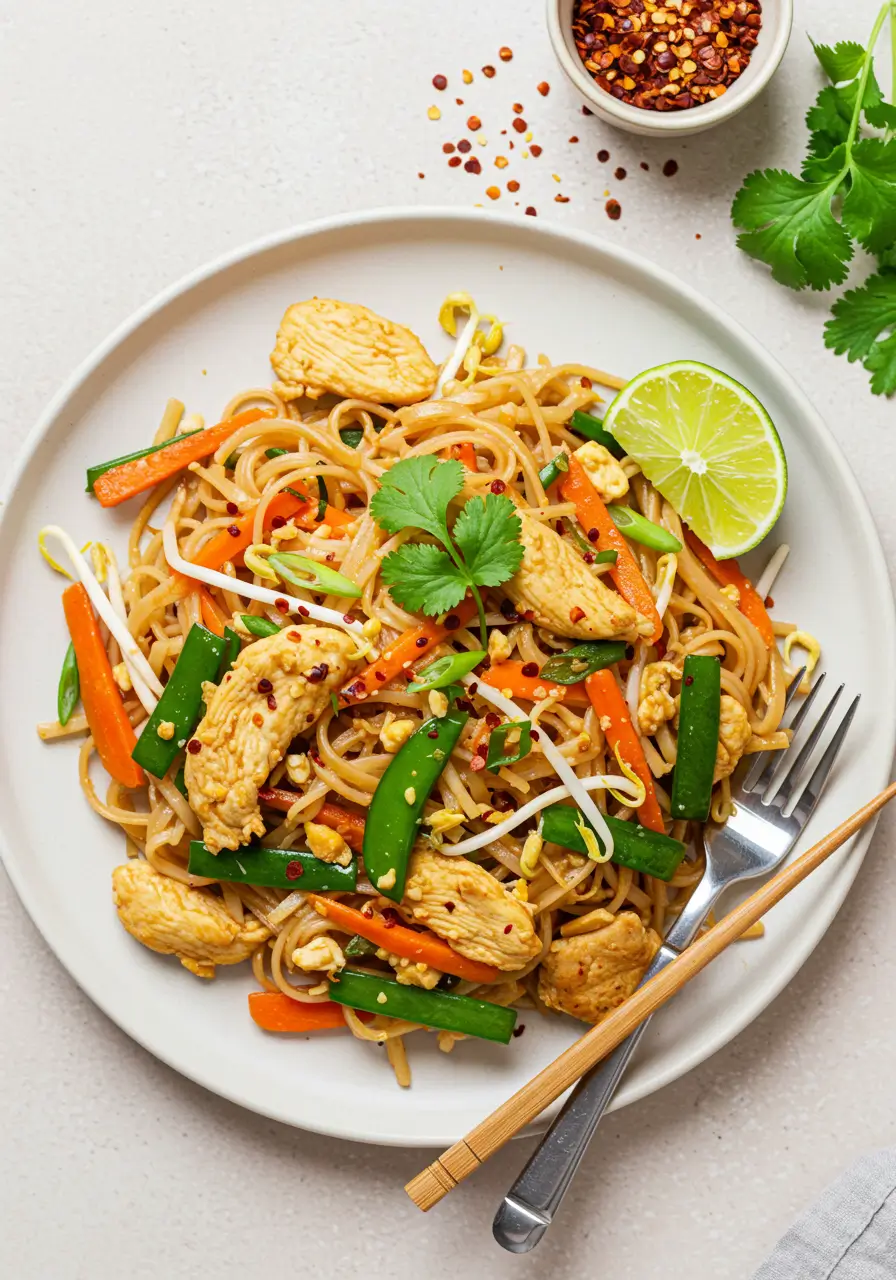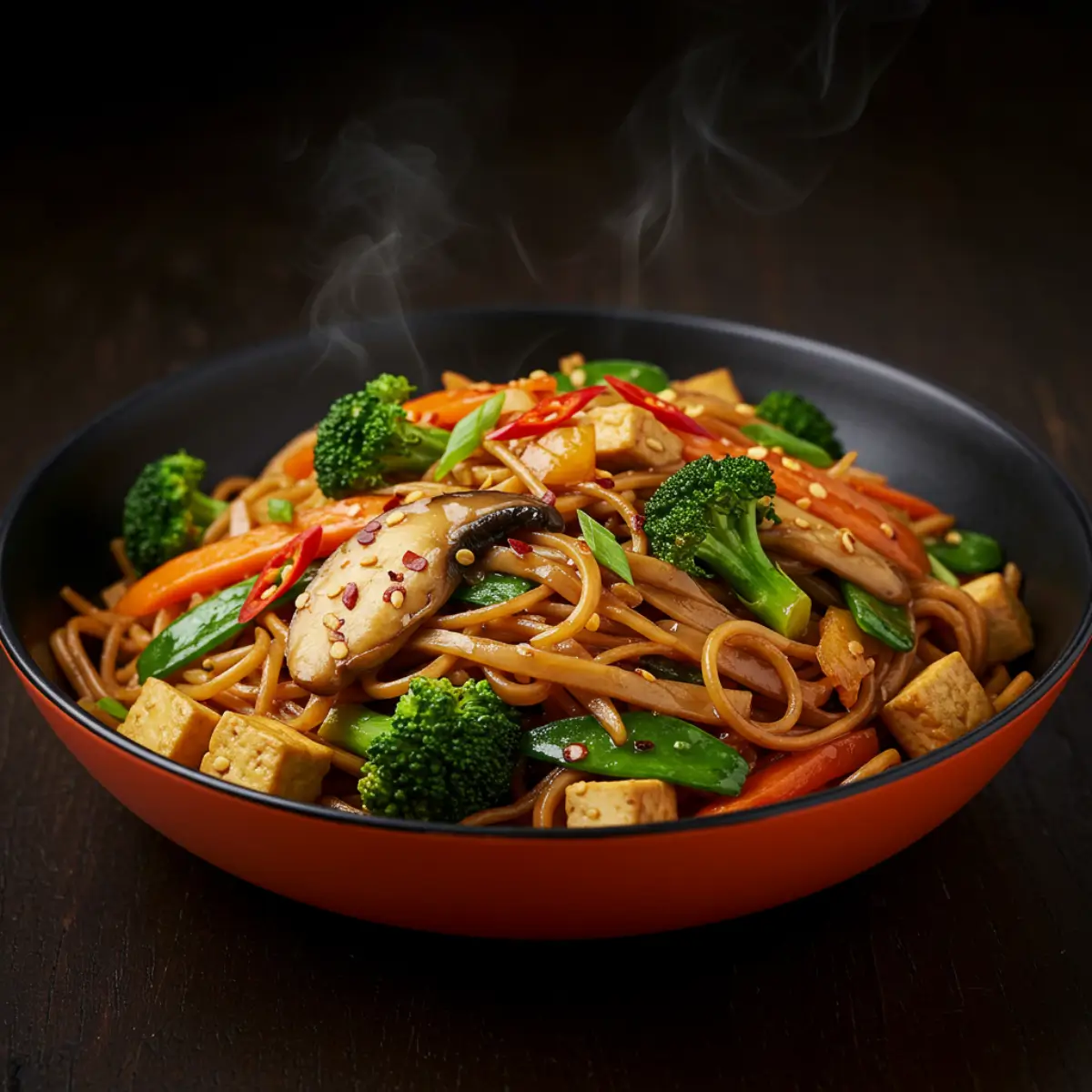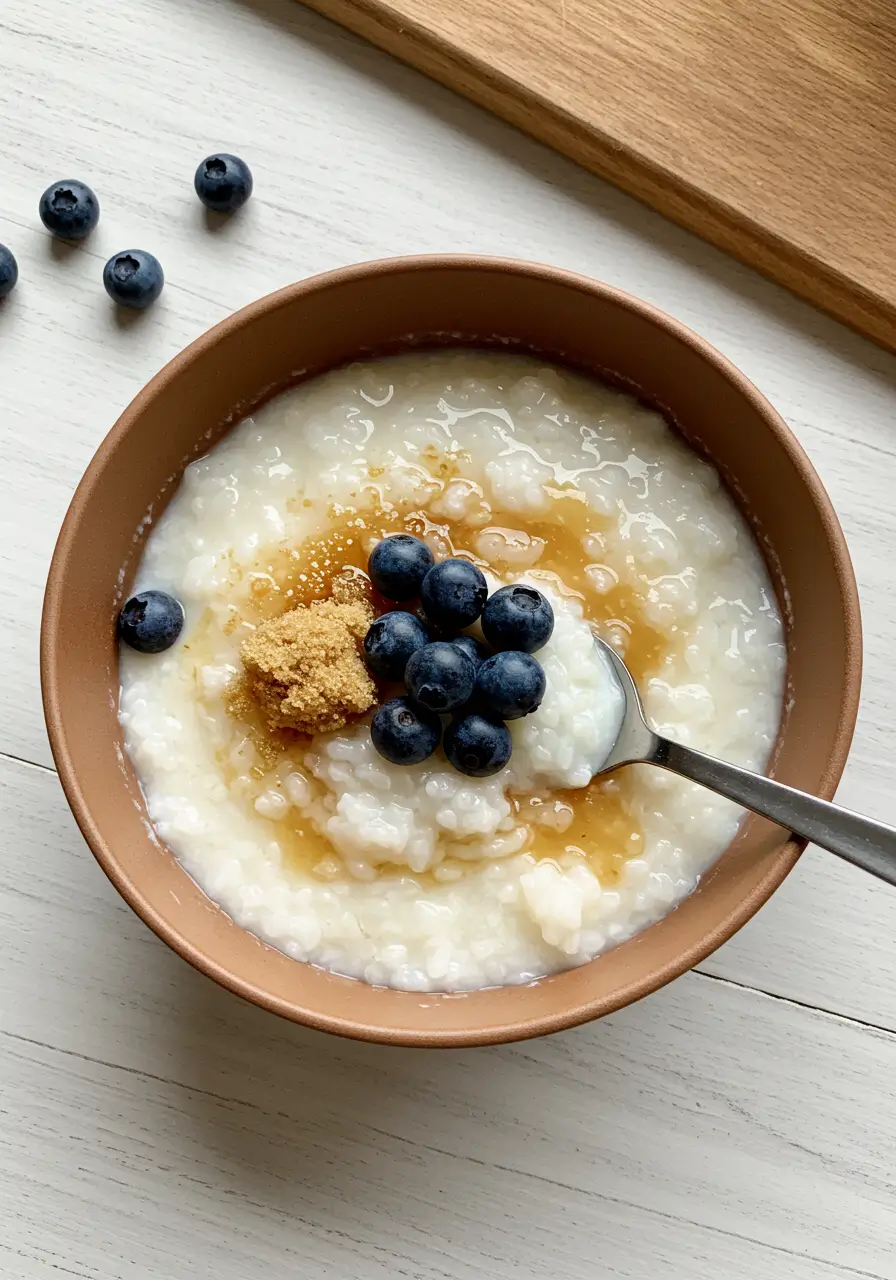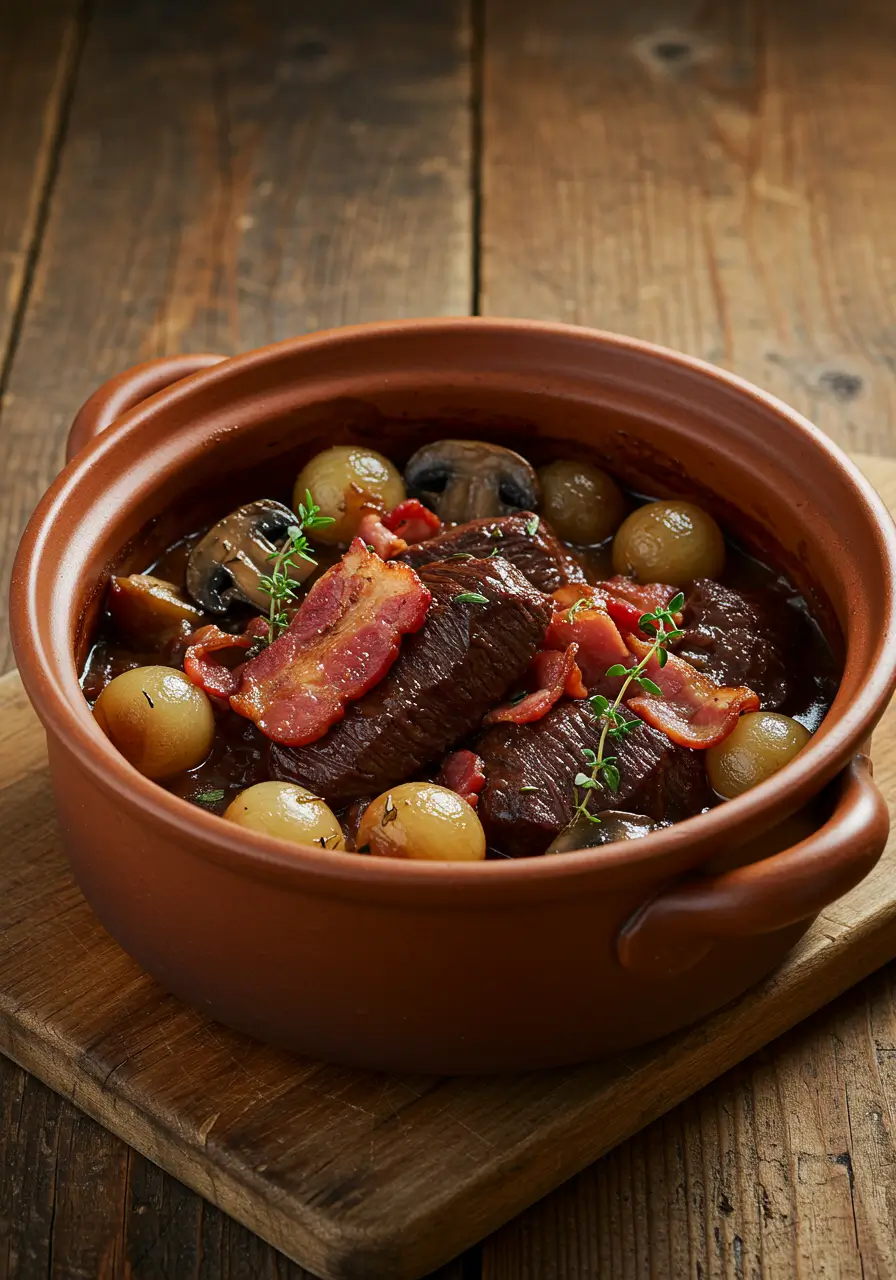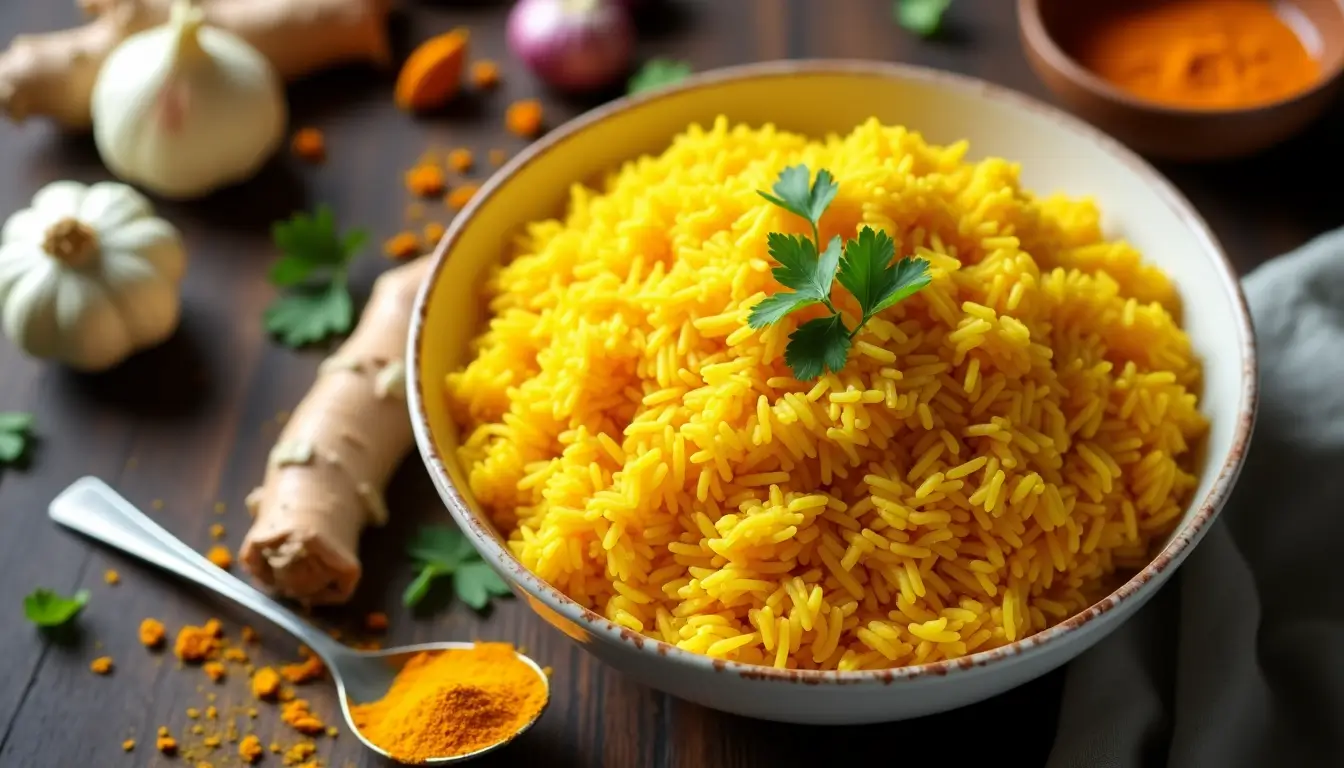pad see ew beef
Let me teach you to make authentic pad see ew with beef that takes just 15 minutes – a perfect choice for busy weeknight dinners. This beloved Thai street food gets its name from its cooking method, which means “stir-fried soy sauce” and gives the dish its signature taste and rich color.
This savory stir-fry stands apart from Pad Thai with its unique combination of wide rice noodles, tender beef, and crispy Chinese broccoli. The dish brings together sweet, salty, and umami flavors in every bite. The magic happens when everything caramelizes at high heat, just like the street vendors do it in Thailand. The traditional pad see ew sauce isn’t spicy, but you can add chilies to kick up the heat.
My recipe will help you create restaurant-quality pad see ew at home. You’ll learn to achieve that perfect balance of flavors and textures that makes this dish a favorite among Thai food lovers.
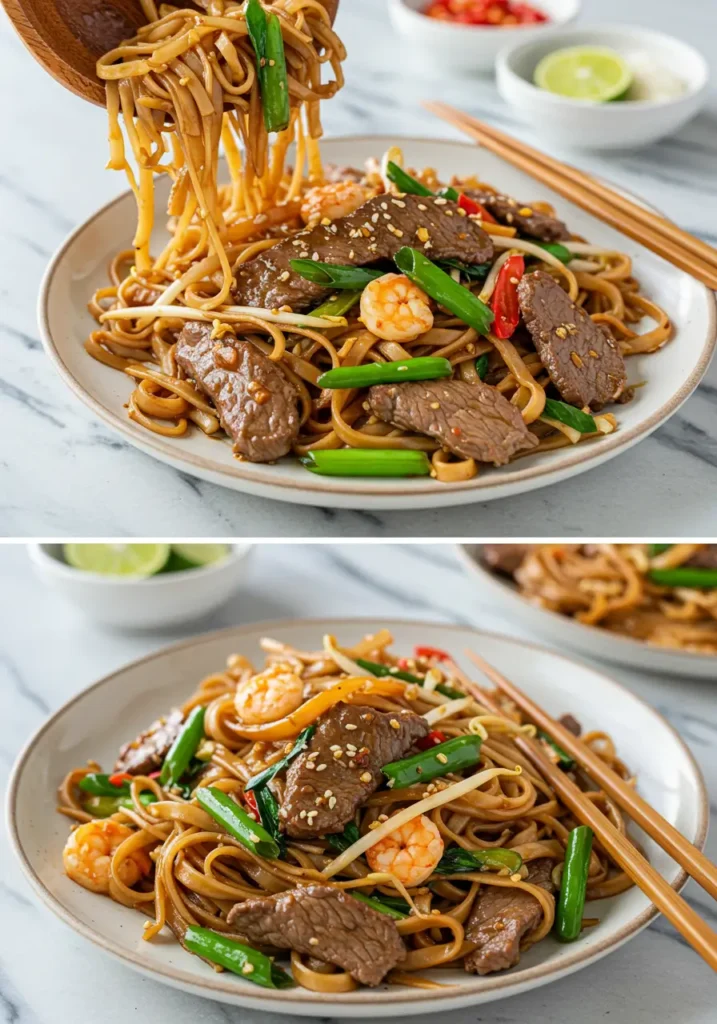
Before You Get Starte:
Success in making pad see ew with beef begins with proper preparation. My experience through countless attempts shows that getting everything ready before heating the wok is significant for this quick-cooking dish.
Key Tips:
The secret to restaurant-quality pad see ew depends on everything in these preparations:
- Slice your beef thinly: I partially freeze my beef for 20 minutes before slicing it against the grain. This will give tender, quick-cooking meat.
- Prepare noodles correctly: Soak fresh rice noodles in warm water to separate them. Using dried noodles requires following package instructions but undercook slightly as they’ll continue cooking in the wok.
- High heat is essential: Your wok should be smoking hot before starting. This creates that signature wok hei – the smoky flavor characteristic of great Thai street food.
- Mise en place matters: All ingredients should be measured and within arm’s reach. The cooking process moves quickly once it starts!
The most common mistake people make is overcrowding the wok. Cooking in batches works best when making pad see ew for more than two people. Each ingredient needs proper contact with the hot wok surface to create those delicious caramelized edges we’re after.
The wok’s heating process shouldn’t be rushed. A properly heated wok distinguishes good pad see ew from great pad see ew. The slight smoke rising signals the right time to add ingredients.
The pad see ew sauce should be mixed beforehand. This helps adjust seasonings before cooking and spreads evenly during the quick stir-frying process.
What Makes This Recipe So Good?
This pad see ew with beef recipe has something truly special about it. The secret lies in balancing flavors and textures that you’ll find in prominent Thai street food.
The magic happens with the seasoning. A perfect blend of soy sauce, oyster sauce, and vinegar comes together with just enough sugar. The beef needs to marinate while you prep other ingredients. This adds amazing flavor that you can really taste.
Here’s what makes this dish stand out:
- A salty-savory-sweet flavor profile from the soy and oyster sauce combo.
- That amazing smoky wok char flavor you get from high-heat cooking.
- Rice noodles with the perfect chew next to crisp-tender Chinese broccoli.
- The noodles caramelize beautifully when they hit the hot wok.
I picked flank steak because it’s budget-friendly and soaks up marinade really well. Chinese broccoli (gailan) gives you that perfect crunch against the soft, chewy noodles.
You’ll love how flexible this pad see ew recipe is. Beef might be traditional, but chicken, pork, shrimp, or tofu work just as well based on what you like. This flexibility makes it great to cook for anyone, and it still tastes amazing.
Everything comes together fast once you’ve got your prep done. It works great for quick weeknight meals or weekend celebrations. Just remember to cook in small batches over high heat. This gives each ingredient that perfect char and makes it taste just like restaurant quality.
Why I Love Pad See Ew Beef Recipe:
Pad see ew has become my comfort food after cooking Thai dishes for many years. This dish holds a special place in my heart, just like it does for many Thai families.
The recipe’s versatility amazes me. I’ve cooked it more than 100 times in the last four years, and now I can make it without even thinking about the steps.
This recipe has become my kitchen staple because:
- It’s surprisingly quick and easy – you can make it faster than getting takeout.
- The sweet-salty-caramelized goodness creates an irresistible flavor.
- You get a well-rounded meal with protein from meat and carbs from noodles.
The best part is how this recipe brings authentic Thai street food flavors to my kitchen. The smell of charred soy sauce takes me back to Thailand’s busy streets.
This dish combines great taste with good nutrition. Chinese broccoli adds vitamins A and C, which makes it a satisfying meal that’s both delicious and healthy.
Pad see ew has grown beyond just being a recipe – it connects people through food. Thai culture’s approach to food shows that recipes like this one bring joy to homes and family gatherings.
Recipe Variations
Want to customize this classic Thai dish? I’ve found many delicious ways to adapt pad see ew that keep its authentic charm.
You can try these protein alternatives to beef:
- Chicken breast or thigh.
- Pork or shrimp.
- Tofu for a vegetarian option.
- Portabella mushrooms for an earthy flavor.
Chinese broccoli can be replaced with several options in your dish. Regular broccoli or broccolini work great when cut into 2-inch pieces with stems attached. Bok choy offers a different yet delightful texture if that’s more your style.
People with dietary restrictions can enjoy this dish with some smart changes. Gluten-free versions of soy sauce and oyster sauce make the dish perfect for gluten-sensitive diets. A vegan version needs just two swaps – use vegan oyster sauce and replace fish sauce with white vinegar.
You can boost the vegetable content by adding zucchini, green beans, bell peppers, snow peas, or water chestnuts. These extras create interesting textures and pack more nutrients into your meal.
These variations let you experiment with new flavors while keeping pad see ew’s essence intact. You can adapt the dish to your taste or dietary needs without losing its authentic appeal.
Equipment
Let me tell you about the equipment you need to make perfect pad see ew at home. The right cooking vessel is vital to this dish’s success.
A carbon steel wok works best. Woks can handle very high heat and give enough space for noodles to char properly. You can also use a large non-stick skillet that handles high heat if you don’t have a wok.
Here’s what you need to get started:
- A well-seasoned wok or large non-stick skillet.
- A wok spatula or tongs for stirring.
- A fine-mesh strainer.
Your cooking vessel’s size plays a big role. A large wok or skillet lets ingredients move freely and cook evenly. Street vendors get that perfect char because they have space to spread out the ingredients.
If you choose a regular skillet instead of a wok, pick one that holds heat well. You need steady high temperatures to make authentic pad see ew. My experience shows that heavy-bottomed pans work best.
Your wok or skillet should radiate heat before you add ingredients. This high-heat cooking method gives you that special wok hei – the smoky flavor that makes restaurant-style pad see ew taste amazing.
Ingredients :
Let me share everything you need to make authentic pad see ew with beef in your kitchen. I’ve laid out these ingredients based on how we’ll use them while cooking.
The beef marinade:
- 8 ounces flank steak, thinly sliced
- 1 teaspoon Thai black soy sauce
- 1 teaspoon vegetable oil
- 1 teaspoon cornstarch
For our pad see ew sauce:
- 2 tablespoons oyster sauce
- 1/2 teaspoon sugar
- 2 teaspoons Thai soy sauce
- 1 tablespoon Thai black soy sauce
- 1 teaspoon fish sauce
For the stir-fry base:
- 1 pound fresh wide rice noodles (or 8 ounces dried rice noodles)
- 3 cups Chinese broccoli, cut into 2-inch pieces
- 3 cloves garlic, thinly sliced
- 2 large eggs
- 4 tablespoons vegetable oil
Fresh wide rice noodles give the most authentic texture, so I recommend using them. These noodles come from a simple mix of rice flour and water, which sets them apart from other Asian noodles. Dried wide rice noodles work great too if you can’t find fresh ones.
The secret to perfect pad see ew sauce lies in Thai-style soy sauces. Dark soy sauce creates that signature color, while regular soy sauce brings saltiness and depth. The combination with oyster sauce delivers that authentic street food flavor we want.
Flank steak makes the best choice because it soaks up marinade well and stays tender during quick high-heat cooking. Chinese broccoli, also called gai lan, adds a nice crunch and slight bitterness that perfectly balances the dish’s sweet-savory profile.
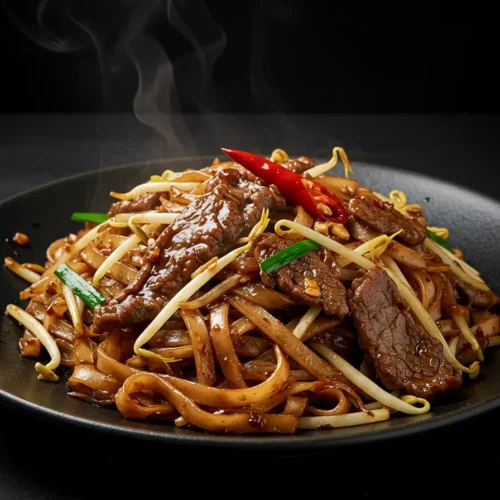
Pad See Ew Beef
Equipment
- A well-seasoned wok or large non-stick skillet
- A wok spatula or tongs for stirring
- A fine-mesh strainer
Ingredients
The beef marinade:
- 8 ounces flank steak thinly sliced
- 1 teaspoon Thai black soy sauce
- 1 teaspoon vegetable oil
- 1 teaspoon cornstarch
For our pad see ew sauce:
- 2 tablespoons oyster sauce
- 1/2 teaspoon sugar
- 2 teaspoons Thai soy sauce
- 1 tablespoon Thai black soy sauce
- 1 teaspoon fish sauce
For the stir-fry base:
- 1 pound fresh wide rice noodles or 8 ounces dried rice noodles
- 3 cups Chinese broccoli cut into 2-inch pieces
- 3 cloves garlic thinly sliced
- 2 large eggs
- 4 tablespoons vegetable oil
Instructions
- Let's take a closer look at making this delicious pad see ew with beef. You'll find each step carefully explained to ensure perfect results.
Preparation:
- The process starts with marinating the beef. The sliced flank steak needs mixing with Thai black soy sauce, vegetable oil, and cornstarch until well coated. The marinated meat should rest while preparing other components.A small bowl works best to combine all sauce ingredients. Keep stirring until the sugar dissolves completely. The sauce mixture should stay nearby for easy access during cooking.Room temperature noodles work best for this recipe. A quick rinse under hot tap water helps if they're cold and stiff. This simple step prevents them from clumping together in the wok.
Cooking:
- Heat your wok until it's smoking hot and spread oil around its perimeter. The beef should be seared until it's about 80% cooked through.These steps are significant for perfect results:– Add garlic to the hot wok and stir-fry for 15 seconds.– Push everything to one side and crack in the eggs, scrambling them quickly. – Add Chinese broccoli stems first, cooking until the beef is almost done. – Introduce the leaves and cook just until wilted.Everything should be removed from the wok after a quick cleaning. The wok needs to return to high heat with fresh oil. This creates the magic – add the noodles and sauce, letting them caramelize for about 30 seconds on each side.The beef mixture goes back into the wok last. Toss everything together until well combined and heated through. The noodles need just 1-2 minutes in the wok to complete the cooking process.
Notes
- Keep noodles and vegetables separate when possible
- Store sauce separately if making ahead
- The wide rice noodles’ texture makes freezing a bad idea
FAQs
Pad See Ew is made with wide rice noodles and has a more caramelized texture due to the dark soy sauce, while Pad Thai uses thin rice noodles and has a tangier sauce thanks to tamarind. Pad See Ew typically has a salty-sweet flavor profile, whereas Pad Thai is known for its balance of sweet, sour, and savory tastes.
While beef is a common protein choice in Pad See Ew, the dish can be made with various proteins or even without meat. Popular alternatives include chicken, pork, shrimp, or tofu for vegetarian options. The versatility of the dish allows for easy customization based on dietary preferences.
For fresh wide rice noodles, ensure they’re at room temperature before cooking. If using dried noodles, soak them in cool or lukewarm water for about 30 minutes until they’re limp but still firm. Drain thoroughly before stir-frying. The noodles will continue to soften during the cooking process.
The unique flavor of Pad See Ew comes from a combination of soy sauces, oyster sauce, and a touch of vinegar. Dark soy sauce provides the signature color and sweetness, while regular soy sauce adds saltiness. The high-heat cooking method also contributes to a smoky “wok hei” flavor characteristic of this dish.
To make authentic Pad See Ew, use a well-seasoned wok or large skillet that can handle high heat. Prepare all ingredients before cooking, as the process moves quickly. Allow the noodles to caramelize for 30-60 seconds without stirring to achieve crispy bits. Cook in small batches to ensure each ingredient gets proper contact with the hot wok surface for that perfect char.

